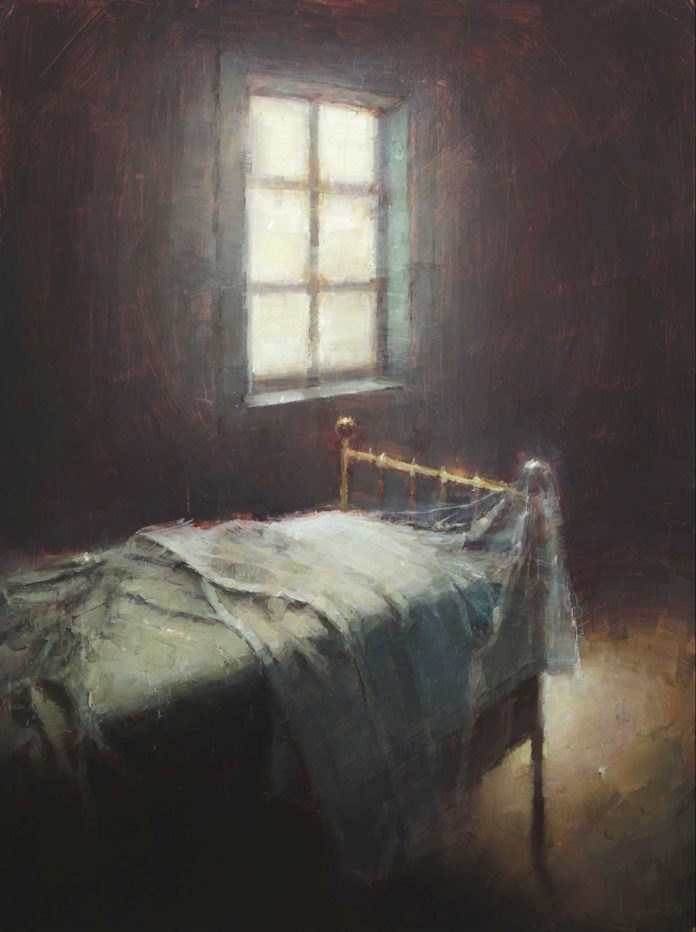By Nicolas Martin
Painting interior scenes has become an important step in my evolution. They have allowed me to change, to be more be attentive to my environment. I started to be more sensitive to what surrounds me. I began to appreciate the banality of a place and finding some beauty. I realized that I am surrounded in all circumstances by interesting subjects as long as there is a source of light. This opened the door to a lot of possibilities, and I never had a day during which I had no subjects to paint.
I do not consider myself a narrative painter, but the development of a story by the viewer is essential for me. I’m not only looking to represent something aesthetic. I tell the beginning of a story and let the viewer continue his or her own. The less information I give, the more people tell me the story that they are seeing and feeling. I find it fascinating because I do not want to own the only truth in my paintings. I want everyone to find theirs. Painting is about sharing, and this is my way of proceeding.
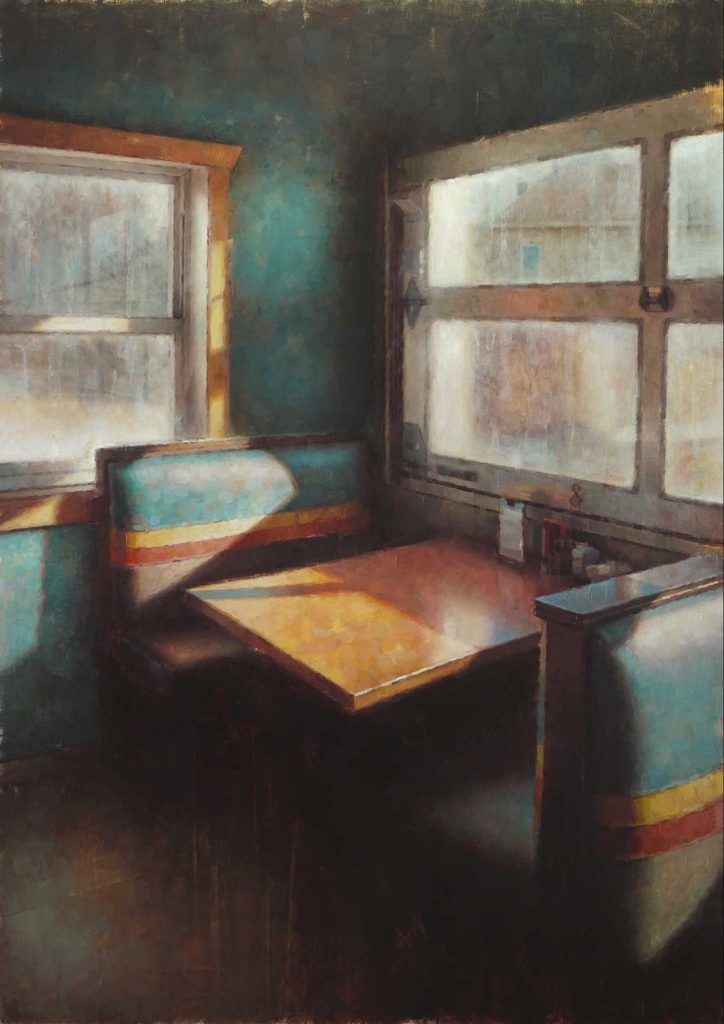
I often like painting lonely places, because I invite the viewer to become the figure in the painting. The painting “Les Banquettes” is a good example. Banquettes is the French term to describe these restaurant booths. I composed my painting with the desire to invite people to sit on these. My paintings, in general, are invitations.
There can be a voyeur aspect, because I place the observer in front of a scene full of intimacy. This intimacy is created by the atmosphere, the apparent simplicity, and the composition. I often use foregrounds that define a framework and invite the viewr to enter into the scene. I want to give just enough information so there is more to discover.
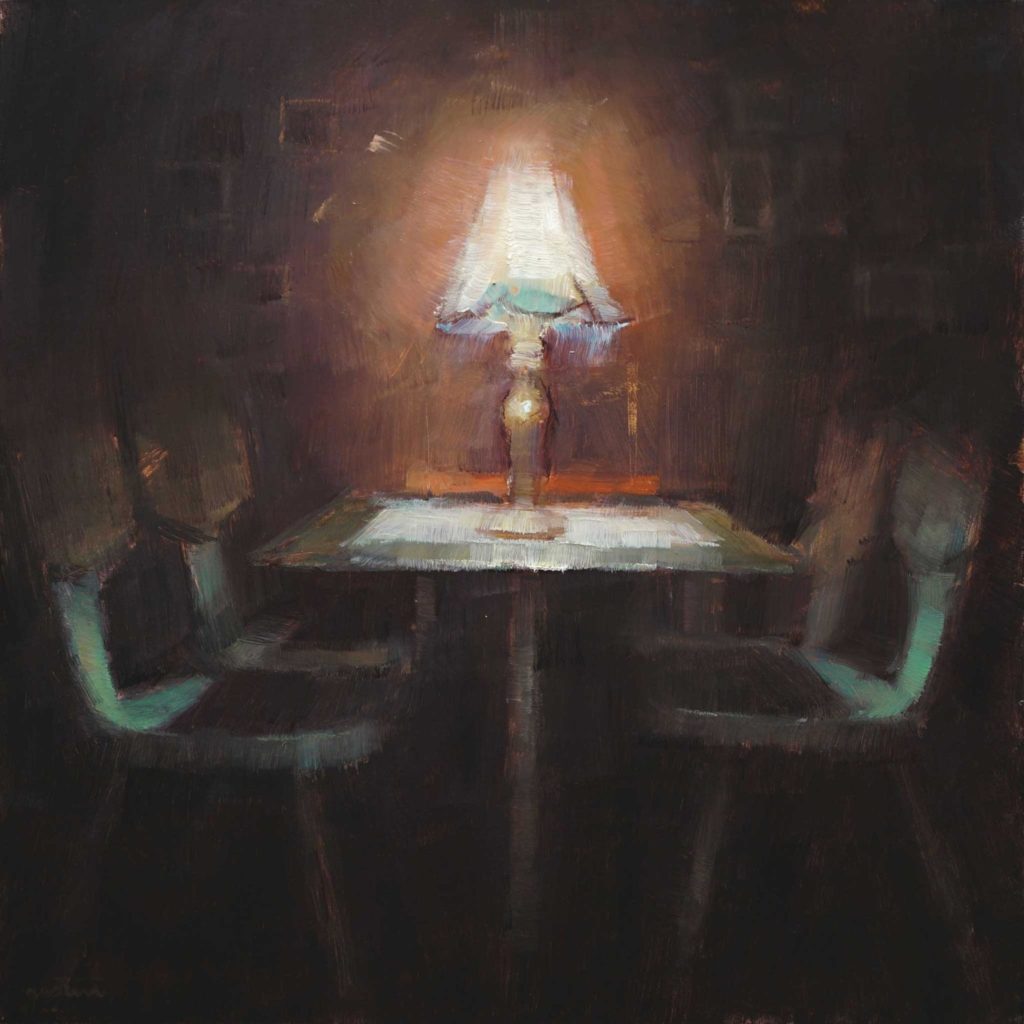
In the painting “Le Rendez-vous,” I invite the viewer to an appointment. I made this painting in alla prima because I wanted to keep the same rhythm, the same mood. Painting in alla prima is an extraordinary sensation — the painting is fresh during all the steps, everything moves, all is in contact. You can paint with thin layers and blend them together while playing with light and shadows. I now want to paint as much as possible in alla prima for this reason. One session, one painting. There is something strong, authentic, and deep about painting in one session. I will paint big paintings in alla prima to see my limits with this process.
I’m looking for some poetry in places that do not always have it. I like the banality of a place that becomes poetic when caressed by light. If I am interested so much in the light, it is for this reason — the fact that light can change a reality.
The way light reacts with its environment fascinates me. I remember when I was a kid and discovered that Claude Monet painted haystacks at different times of the day. It was a revelation for me. I found a meaning to the painting that connected with me — the ability to depend on light and tame it, chasing it.
Over the years, my way of painting light has evolved. I understood how I wanted to represent it, but I was looking for more. The years have led me to refine my technique, to be lighter in my application of layers, to take care of the light. Every brushstroke counts, and I know every step brings me to my goal.
I am looking for depth and painting the air, to make the viewer feel this suspended light ready to change. I have a notebook where I write down the times, places, and how light affects a scene. I like this search for a specific moment. I like to make the comparison with a musical instrument.
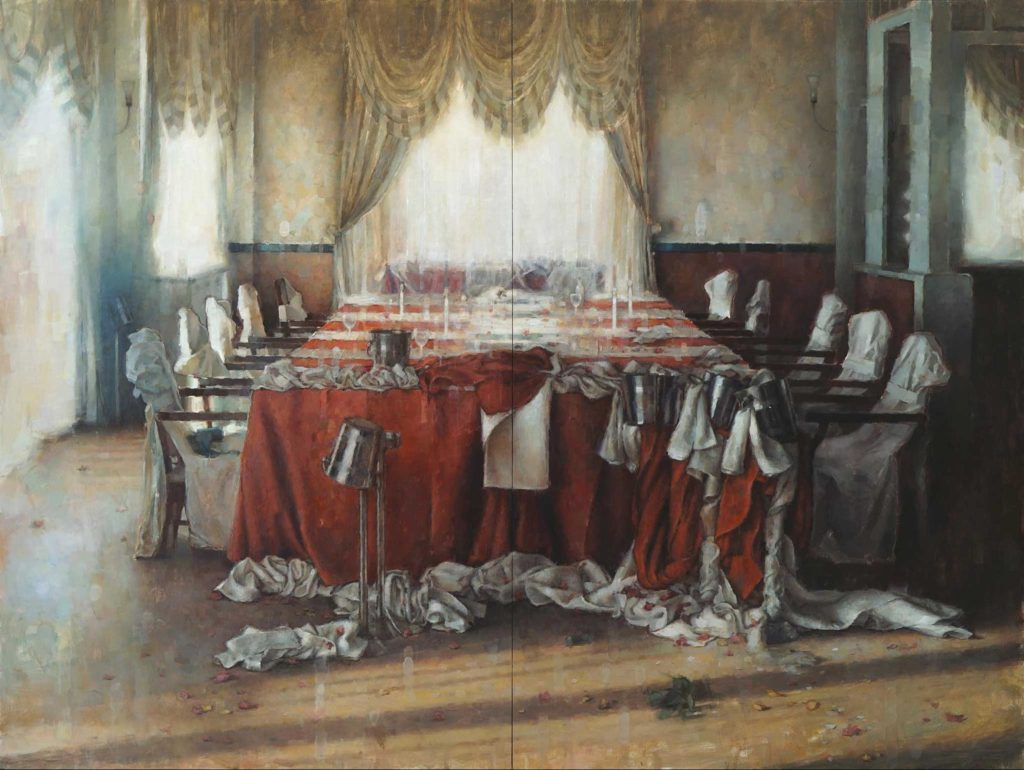
The choice of support can also play an important role in the meaning of the painting. This painting represents a wedding table after the party. I decided to paint on two large panels and assemble them together to symbolize the union of two people. The visible junction of the two panels plays its role in the scene.
When you set the pickups of an electric guitar you are looking for the sweet spot — this allows the instrument to flourish and show its real abilities. Every guitar should react differently, so this setup is unique for each one. I am always looking for the sweet spot while I am searching the right moment at the right place. This is another reason why I like to paint very common places. Would this place be sublime at another time? Probably. The contrast is even more interesting when it is a banal place at first sight.
I feel like a light hunter. It’s a special energy that keeps me awake all the time. I want to discover new places that influence me. All the imagery around me also has an impact on my painting. I feel like a sponge. I leave the space and I keep the images fresh in my mind.
What I am keeping today would not have interested me yesterday. It’s interesting to feel my eyes evolve, to refine what surrounds me.
I see beauty in what is not supposed to be beautiful according to the ideal of beauty of our time. I have been a designer in the past, and I think it has been important for me to experience this before. The aesthetic rigor could have been a cage in which I could lock myself very easily. The day I started painting, I stopped being someone else.
I do not want my paintings to be only aesthetic moments; there is always a reason behind it. Since most of my paintings are invitations, people’s reactions (so they tell me) are very often based on what they would like to do in this room.
They identify and interact with the scene. I am always fascinated by these discussions, their feelings about what this scene represents to them. They are talking to me like I didn’t create this painting. I understand very well that my work does not belong to me anymore. When I paint interiors, I know that people can easily recognize themselves in these scenes. These are places that often bring them back in their memory. I rarely paint modern interiors for this reason. I do not feel the weight of history — it feels empty. I have nothing to tell despite the fact that I could find a certain aestheticism.
I want to transport people in their memories as I do with myself. I think most people have this sensitivity. The viewer sees a chair and a window in a room and these elements are whistling to evoke memories. That’s why I’m a figurative painter.
Representing calm and quiet moments is also a characteristic of my work because it is a state that I look for. I find that it goes with intimacy — it’s like lowering the sound of a room. If I put all my paintings side by side, there is a calm and intimate aspect that emerges even when the subject is not supposed to be in this category. When I paint a crowd on a street, the first thing I will look for is intimacy, even more in this kind of scene. Later, I realized, it allowed me to better understand myself.
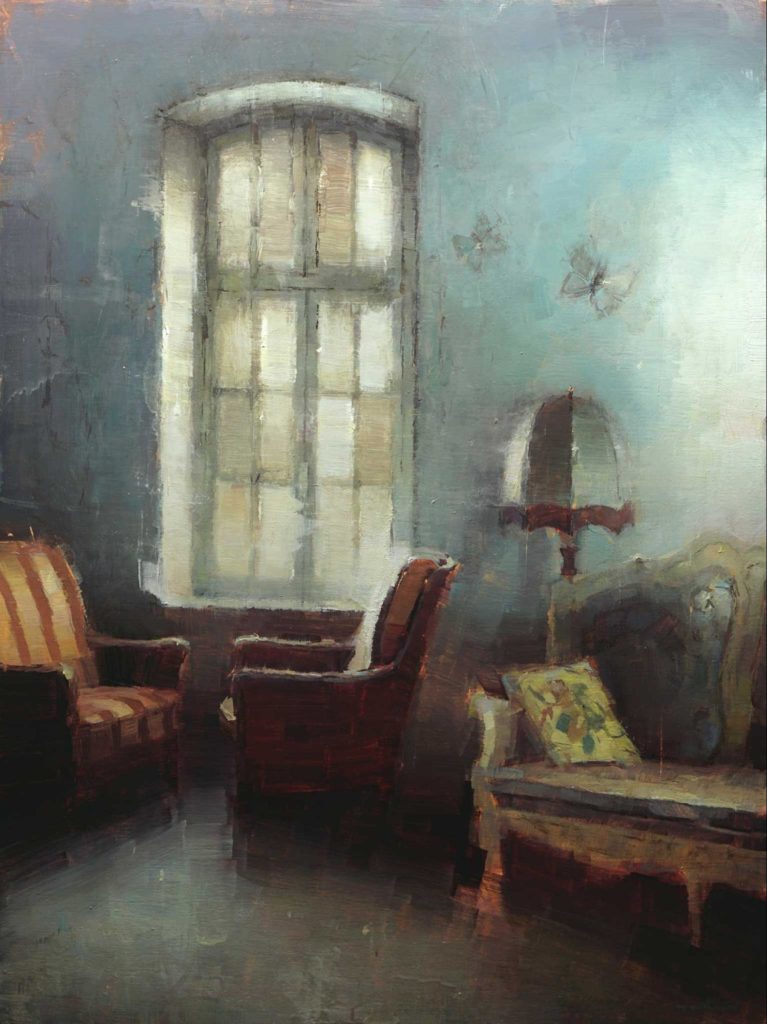
When I began painting, I was fascinated by the codes and references that some painters of the past were able to integrate into their canvases. They found a way to stay in control of their work or to convey a message. As my paintings leave the studio, I lose this link that I had for many hours of work. So I began to think about the use of elements of my daily life in my paintings, that way while the canvas no longer belongs to me, I still keep a link with it in this way, a confidence between the paintings and myself.
For example, when my wife told me that she was pregnant and we would have a second child, I decided to integrate two butterflies in the painting in front of me. The meaning of the painting changed after this wonderful news. It is now called “The Butterflies,” and this painting celebrates this beautiful moment. If I don’t explain it, it will be a very different story for the viewer, so I rarely say what I incorporate into paintings, to not influence people in their reactions.
An event in my life can change the full meaning of my paintings. When I live an important moment that I want to keep, I select an element around me and then integrate it into my painting. It can be absolutely anything as long as it makes sense to me. It can be a number, a word, a pattern of curtain or carpet, a piece of clothes, a jewel — I want to think that I can change the meaning of my painting at any time in relation to what I live. I started painting in this way from the beginning, and my paintings are chronologically related to my life. It is not understandable if the person is not aware of it.
A Chronology of My Life, a Visual Testimonial
It was important for me to know why I decided to paint. When I made the decision a few years ago, I had to organize my life around painting so I needed to understand it. What I learned: I wanted to express myself and evolve. Painting allowed me to know myself better and feel more connected with my environment. It is a good thing to understand our own approach; it can help to better target our needs, desires, and goals.
The desire to evolve and progress is crucial. Painting interiors is the result of a logical reflection.
I painted outdoor night scenes with people, so it was crucial for me to paint lonely interiors scenes. (Painting the opposite of what I knew to evolve.) I always wonder what to do to move forward. I am not a painter of a single subject. I never saw myself painting some fruits in a bowl for the rest of my life. It does not make sense to me. If my reason for painting is to express myself, then why repeat the same thing again and again? In a discussion it would be meaningless, so it’s the same about painting, in my opinion.

I want to express myself but what I have to say does not take into account what is happening in the world. I sometimes watch the news, but it does not influence me in my choice of painting. I focus on my life, what I live personally, my surroundings, my discoveries, the people I meet. I don’t want to include political messages in my paintings. I do not seek to inform or denounce even if I can understand the people who do it. They express themselves, and I respect that. For the moment, my desire is not there.
I ask myself a lot about painting but never about my own place in today’s world of art. I am not interested in art movements at all. The questions I ask myself are about the meaning of what I’m doing and my visual identity. I wonder about my evolution and how to proceed, what I want to share with people.
I painted a lot of different subjects because I had this desire to discover new things, to focus on my weaknesses so that they become strengths. To insist where it hurts. I refuse to have a methodology or a routine. If I feel that I do not progress with what I’m actively working on anymore, then I seek the key to advance and evolve. It often passes by a change of subject, brushes, colors or, of course, different locations.
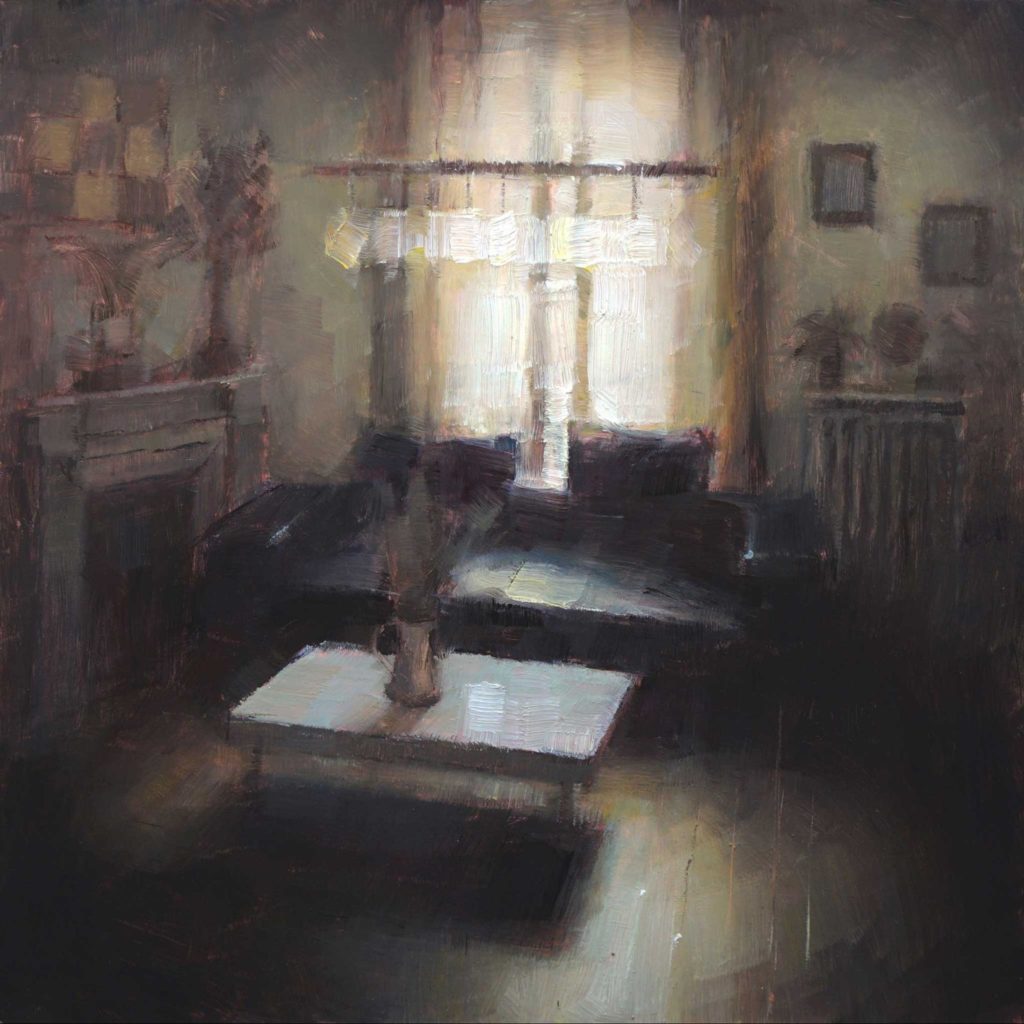
When I started painting with a single medium-large brush, I felt myself moving forward. I did not have to paint some areas of my canvas with a different brush. I was looking for homogeneity — and forcing myself to stay with only one tool helped me a lot. I was looking for a balance. I also use the knife a lot. It allowed me to break my forms and to question myself. I break my routine until it becomes one itself.
This then led me to think of something important: As a man I have flaws, so why should I try to correct my paintings until there are no flaws? If I want to be honest with myself, I cannot ignore my flaws. If I decide to consciously leave mistakes, they are no longer mistakes — they are my identity.
From that moment on I had contradictions in my brain, and I had to learn what to leave and what to keep. What to correct and what not to correct. My perspective changed from that moment on. My lines have become less straight, no longer respecting the logical pattern. No more golden ratio, no more mahl stick. I felt trapped and I wanted to escape. Today I know where I am going: I am looking for freedom.
For example, I loved the fine details of paintings when I was younger. Today I am more touched by a less static perspective, less respectful of reality, less corrected. I want to discover someone’s vision rather than the ideal representation. My ideal of beauty has changed, so I’ve discovered many paintings that I didn’t see as interesting many years ago. I discovered a deep authenticity.
Today when I compose a painting, I do not put any limits on my process. I know that I can change, deform, remove. I do not have to respect what the subject is supposed to be.
I want to be free when I’m facing a blank canvas. I just want to express myself with my freedom and my identity.

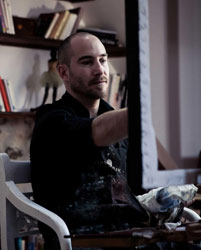
About the Artist:
Nicolas Martin (www.theartofnicolasmartin.com) (b.1980) is a French artist from Paris, now living and working in Montreal, Canada. After completing his studies at the respected Auguste Renoir school in Paris, Nicolas decide to deepen his artistic knowledge and diversify his skills by completing the Graphic Design program at the University of Laval in Quebec, Canada.
In 2003 he won First Prize in the “La Fondation de la Vocation” scholarship in Paris. Throughout his career, Martin has worked as a designer for the famous Galeries Lafayette in Paris and as art director for various companies in Europe and North America.
He started his career as a professional painter in 2013 with a highly successful solo show at the L’Oeil du Prince Gallery in Paris, followed by a second equally successful solo exhibition there the following year. In 2015 he made his U.S. debut in “Urban Life” at Abend Gallery in Denver and was a finalist at the respected ARC Salon. He was also named an “Artist to Watch” by Southwest Art magazine and featured in the book Tall Trees of Paris. Nicolas’s work has also recently been included in the “Realism Without Borders” international group and exhibitions, as well as featured in the Jetset Collection exhibition at Vanessa Rothe Fine Art in California.
In 2016, his third solo exhibition at the L’Oeil du Prince Gallery in Paris, entitled “Cinemascope,” was highly acclaimed and proved to be another successful achievement for his career. Nicolas is proud to be exhibiting among top artists. His work is now widely collected in both Europe and North America. His primary goal as a painter: constant evolution.
Sign up to receive Fine Art Today, the free weekly e-newsletter from
Fine Art Connoisseur magazine.

